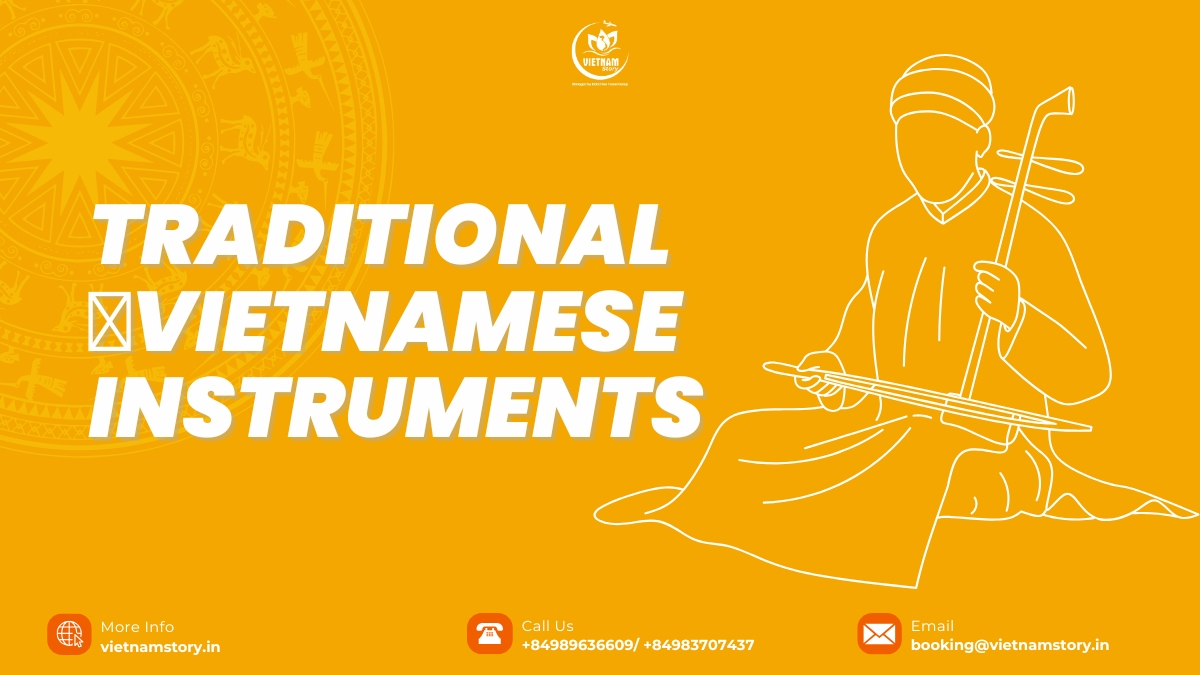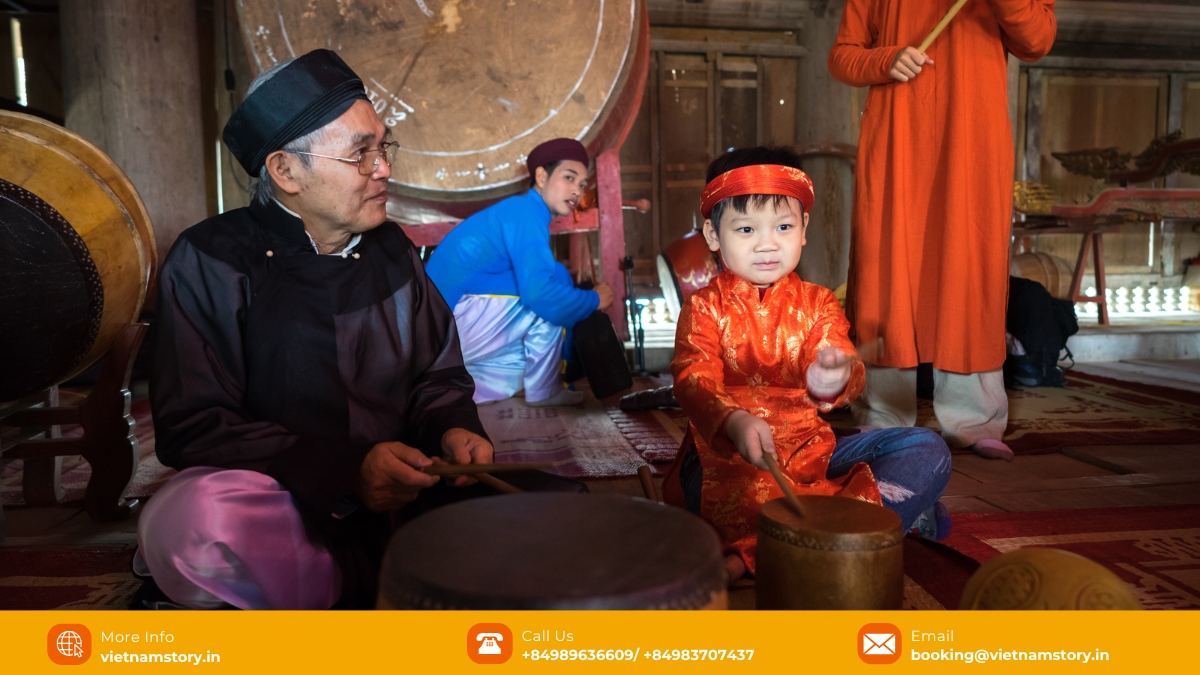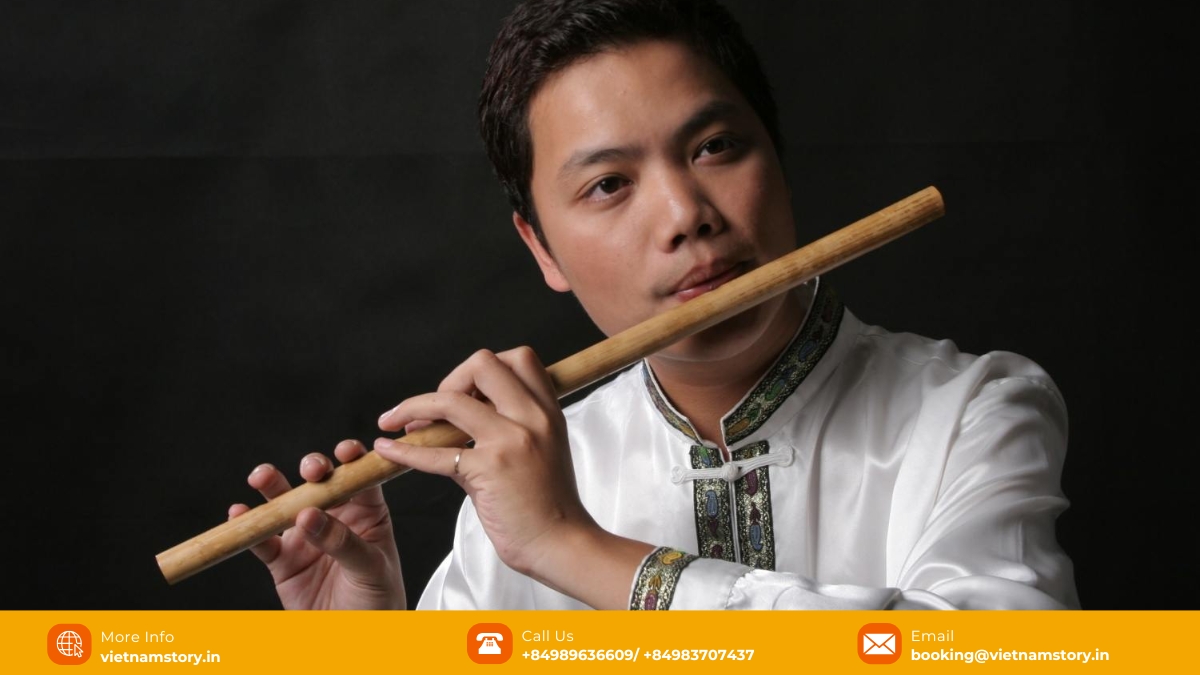Vietnam, a land of breathtaking landscapes and vibrant culture, resonates with the echoes of a rich musical heritage, a priceless treasure established over thousands of years. For travelers, especially those from India seeking deep cultural connections on their Vietnam tours, exploring the world of traditional Vietnamese instruments offers a unique window into the nation’s soul. Beyond the bustling cities and tranquil countryside lies a universe of sound, where each instrument tells a story, carries tradition, and forms a vital part of the spiritual and social fabric of Vietnamese life. These are not merely tools for creating melodies; they are cultural ambassadors, echoing the history, resilience, and artistic ingenuity of the Vietnamese people. From the haunting whispers of the Đàn Bầu (monochord) to the powerful rhythms of the Cồng Chiêng (gongs) in the Central Highlands, traditional Vietnamese instruments provide a captivating soundtrack to the Vietnamese experience. This guide delves into the fascinating world of these ethnic instruments, exploring their diverse forms, historical roots, unique characteristics, and their enduring importance within Vietnamese culture.

The History and Significance of Vietnamese Musical Heritage
The history of traditional Vietnamese instruments is a captivating journey reflecting the nation’s cultural richness and resilience. Over centuries, a diverse array of instruments has been cultivated, encapsulating the essence of the Vietnamese people. This collection showcases the creativity of local artisans who crafted unique instruments with distinct indigenous features. Simultaneously, Vietnam’s musical landscape embraced instruments from diverse origins (like China, India, and Persia), skillfully adapting and indigenizing them into authentic expressions of Vietnamese identity. This harmonious blend of tradition and adaptation defines Vietnamese music. Boasting hundreds of different types, these instruments serve as vital conduits connecting generations, preserving a rich musical heritage, and acting as storytellers expressing emotions, narrating tales, and underpinning rituals, ceremonies, and communal events from folk songs to the elegance of Nha Nhac (Vietnamese Court Music).
The Main Types of Traditional Vietnamese Instruments
Vietnamese traditional musical instruments are broadly categorized into three main types, each contributing uniquely to the nation’s rich sonic tapestry:
1. Vietnamese String Instruments (Bộ Dây): A Delicate Dance of Sound
String instruments (nhạc cụ dây) form a vital part of the Vietnamese musical landscape, their diverse timbres capable of expressing a wide spectrum of emotions, from melancholic yearning to vibrant joy.
- Monochord (Đàn Bầu): Perhaps the most unique and iconic Vietnamese instrument, the Đàn Bầu features just a single string stretched over a bamboo or wooden soundbox. Sound is coaxed out using a pick or plectrum while manipulating a flexible rod attached to the string to alter pitch, creating distinctive glissando effects. Its haunting, expressive, and soulful tones can mimic the human voice, making it perfect for conveying deep emotions in solo performances and accompanying folk songs like Xẩm singing.
- Moon-shaped Lute (Đàn Nguyệt): Instantly recognizable by its round, moon-like body, the Đàn Nguyệt is a two-stringed lute with a long neck and high frets. Originating around the 11th century, it’s essential in both folk and court music (Nha Nhac). Its sound can be soft and nuanced or vibrant and crisp, capable of expressing various moods. It’s widely used in ensembles, ceremonial music, and accompanying traditional singing.
- 16-string Zither (Đàn Tranh): This long zither typically features 16 steel strings (though modern versions with 17, 22, or more exist) stretched over a curved wooden soundbox with movable bridges. Played by plucking with picks (often tortoise-shell), the Đàn Tranh produces bright, cascading, and harp-like melodies. It’s a prominent instrument in traditional orchestras, solo performances, and chamber music, dating back to at least the 13th century.
- Two-stringed Fiddle (Đàn Nhị): A versatile bowed string instrument with two strings and a distinct resonator often covered in snake or python skin. Descended from instruments originating in India and China (around the 10th century in Vietnam), the Đàn Nhị (also known as Đàn Cò) produces emotive, lyrical sounds crucial to genres like Chèo (traditional opera) and Cải Lương (reformed theatre), as well as various folk traditions across different ethnic groups.
- Pear-shaped Lute (Đàn Tỳ Bà): A four-stringed lute with historical roots in China (Pipa) and Japan (Biwa). Traditionally using silk strings (now often nylon), the Đàn Tỳ Bà has a distinctive pear-shaped body and produces clear, bright high tones and rich bass tones. It holds a prominent place in folk music ensembles and orchestras.
- Three-string Lute (Đàn Đáy): This unique instrument features 3 strings, an exceptionally long neck with high frets, and a shallow, often uncovered soundbox. The Đàn Đáy produces a warm, mellow, yet somewhat muted timbre. Historically, it was the essential accompanying instrument for the traditional art forms of Ca Trù (also known as Hát A Dao or Hát Cửa Đình) singing.
- 36-string Hammered Dulcimer (Đàn Tam Thập Lục): Originating from the Persian Santur around the 12th century and introduced to Vietnam in the 1960s, the Đàn Tam Thập Lục is a hammered dulcimer with 36 metal strings (though modern versions may have more for chromatic capabilities). Struck with light bamboo hammers, it produces bright, metallic tones and plays a significant role in modern traditional orchestras and accompanying Chèo and Cải Lương.
2. Vietnamese Wind Instruments (Bộ Hơi): Voices of Tradition and Nature

Often crafted from bamboo or wood, wind instruments (nhạc cụ hơi) add soulful melodies and resonant tones to the Vietnamese soundscape, often evoking the sounds of nature.
- Bamboo Flute (Sáo Trúc): The simple yet expressive Sáo Trúc is a transverse flute typically made from a single piece of bamboo. With a blowing hole and typically 6 (or sometimes 10) finger holes, it produces clear, pure tones spanning over two octaves. Deeply ingrained in folk music and culture, its image is intertwined with Vietnamese rural life, used in solos, orchestras, and accompanying songs.
- Gourd Mouth Organ (Kèn Bầu): A distinctive double-reed wind instrument, similar to an oboe or trumpet, the Kèn Bầu is notable for its bell, which is made from a dried gourd peel (‘Bầu’ means gourd). It produces a strong, resonant, high-pitched sound, often featured in traditional court music (Nha Nhac), ceremonial music (especially weddings and funerals), and Chèo orchestras.
- Mouth Organ (Khèn): Belonging to the free-reed aerophone family, the Khèn has a complex structure with multiple bamboo pipes passing through a wooden windchest (often gourd-shaped). Each pipe has a metal reed. It’s a polyphonic instrument, producing rich harmonies, and plays a vital role in the community bonding and cultural expression of ethnic groups like the H’Mong in Vietnam’s northern mountains.
3. Vietnamese Percussion Instruments (Bộ Gõ): The Rhythmic Heartbeat
Percussion instruments (nhạc cụ gõ) provide the rhythmic foundation, energy, and accents essential to Vietnamese music, ranging from resonant drums to ancient stone chimes.
- Drums (Trống): Various drums form the core of Vietnamese percussion. Notable is the Trống Cơm (“rice drum”), a traditional bongo-shaped drum whose pitch is uniquely adjusted by applying hot sticky rice mash to the drumheads (buffalo skin) before playing. It produces a deep, resonant, slightly muffled sound and is integral to Chèo orchestras and ceremonial music. Other drums like the large Trống Cái provide foundational beats.
- Gongs (Cồng Chiêng): Indispensable to the spiritual and cultural life of many ethnic groups, especially in the Central Highlands, Cồng Chiêng are ensembles of tuned gongs made from copper alloy. The knobbed version is ‘Cồng’, the flat ‘Chiêng’. Their resonant sounds vary with size and are central to rituals, festivals, and community life. The Space of Gong Culture in the Central Highlands of Vietnam is recognized by UNESCO as a Masterpiece of the Oral and Intangible Heritage of Humanity.
- Lithophone (Đàn Đá): One of humanity’s oldest musical instruments, the Đàn Đá is Vietnam’s most ancient percussion instrument, with examples dating back over 3,000 years. It consists of a set of stone slabs of varying lengths and thicknesses, crafted to produce different pitches when struck with hammers (mallets). Found primarily in the Central Highlands, its clear, resonant tones echo the sounds of mountains and streams.
- Bamboo Xylophone (T’rưng): Another popular instrument from the Central Highlands ethnic groups, the T’rưng is an idiophone made of varying lengths of hollow bamboo tubes suspended in a frame. Played by striking the tubes with soft mallets, it produces light, bubbly, and melodious sounds, often described as resembling flowing water.
- Clappers (Phách): Simple yet essential rhythmic instruments, Phách are wooden or bamboo blocks struck together to provide a steady beat, often used in teaching, rehearsals, and certain musical genres like Ca Trù.
A Cultural Tapestry Woven with Sound: The Role of Instruments

Traditional Vietnamese instruments are far more than just sound-producing objects; they are cultural artifacts embodying centuries of history, artistry, and societal values. Their melodies are the voices of generations, carrying forward folk tales, spiritual beliefs, and community identity. They are central to:
- Folk Music & Daily Life: Accompanying storytelling, folk songs (dân ca), dances, and community gatherings across Vietnam’s diverse regions.
- Royal Court Music (Nha Nhac): Providing the elegant and refined soundscape for imperial ceremonies, recognized by UNESCO. Instruments like the Đàn Nguyệt, Đàn Tỳ Bà, and Kèn Bầu are prominent here.
- Theatrical Genres: Forming the backbone of traditional operas like Chèo and Cải Lương, enhancing dramatic tension and emotional expression with instruments like the Đàn Nhị and Trống Cơm.
- Rituals & Ceremonies: Playing indispensable roles in religious ceremonies (Buddhist, Caodaist), life-cycle events (weddings, funerals), and agricultural festivals, with instruments like Cồng Chiêng holding deep spiritual significance for ethnic groups.
- Festivals & Celebrations: Adding vibrant energy and cultural character to events like the Lunar New Year (Tết) and village festivals throughout the country.
Experiencing Traditional Vietnamese Music on Your Tour
For travelers exploring Vietnam, seeking an authentic cultural immersion, witnessing a live performance of traditional Vietnamese instruments is highly recommended. Opportunities abound:
- Traditional Theaters & Shows: Cities like Hanoi and Ho Chi Minh City host performances, including the famous Water Puppet shows which often feature live traditional music orchestras playing instruments like the Đàn Bầu, Sáo Trúc, and Đàn Nhị. Look for dedicated traditional music venues or cultural centers.
- Cultural Festivals: If your Vietnam tour package coincides with a local festival, especially in regions like the Central Highlands or rural northern areas, you might encounter performances featuring Cồng Chiêng, Khèn, or various folk ensembles.
- Hotels & Resorts: Some high-end resorts and hotels, like those offered by Vinpearl in destinations like Ha Long Bay, Phu Quoc, Nha Trang, and Hoi An, may feature cultural performances including traditional music for guests.
- Music Conservatories & Workshops: For a deeper dive, consider visiting a music school or workshop where you might observe lessons or even try playing an instrument yourself.
Listening with an open mind and respectful attitude allows the unique timbres and emotional depth of Vietnamese traditional music to transport you, offering a profound connection to the country’s rich cultural heritage.

Conclusion: The Enduring Resonance of Vietnamese Instruments
The traditional Vietnamese instruments are a vibrant testament to the country’s enduring cultural legacy and artistic soul. From the intricate craftsmanship of the Đàn Tranh to the ancient echoes of the Đàn Đá and the spiritual power of the Cồng Chiêng, each instrument offers a unique narrative and sonic beauty. Exploring this musical world provides invaluable insights into Vietnamese history, beliefs, and ways of life. As you travel through Vietnam, let the haunting melodies of the Đàn Bầu, the joyful rhythms of the T’rưng, and the soulful calls of the Sáo Trúc enrich your journey. These sounds are more than just music; they are the heartbeat of Vietnam, a cultural treasure waiting to be discovered and appreciated, resonating long after your visit concludes.
READ MORE: Unveiling the Rich Tapestry of Vietnamese Culture: A Journey for the Senses











